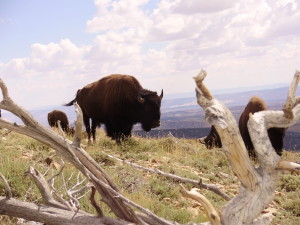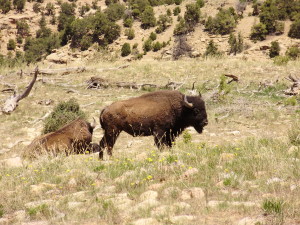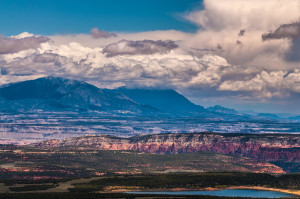ST. GEORGE — Dustin Ranglack has been studying the Henry Mountains bison herd for years. Recently, the herd was discovered to be considered a genetically “pure” herd, meaning they have no cattle genes in their bloodlines. They are also free from brucellosis, a disease which affects cattle and bison. Together, this makes the Henry Mountains bison a very important herd.

There was once a time, hundreds of years ago, when an estimated 30-60 million bison were living in North America, according to the U.S. Department of Fish and Wildlife. As settlers came to the continent and pushed west, increased pressure from hunting began to take its toll on the herds.
During the 1870s, a massive slaughter began, fueled by the profitability of bison hides and bones. This bloodbath was so severe that by 1884 there were only an estimated 325 bison left in the wild.
Since then, bison populations have slowly begun to recover. There are now an estimated 30,000 bison living in wild herds, with more than 400,000 in domestic herds, according to Defenders of Wildlife.
Few of these herds are genetically free from cattle DNA. The Henry Mountains herd is one of those herds, Ranglack said.
Ranglack was a student at Utah State University when he first began studying wildlife. His initial forays into his studies were predators.
“I was mostly interested in mountain lions and wolves and bears,” Ranglack said. “But then I was offered a chance to do a Ph.D. study on the Henry Mountain bison there at Utah State, and I took it and I’m really glad I did. It’s really interesting; I learned a lot of really neat stuff.”
Ranglack spent the better part of five years studying the Henry Mountains bison.
“I lived down there for three full summers on the mountain, following them around,” he said. “I would get down there on the weekends during the school year as much as possible.”
During the summer, researchers would set up a field camp at one of the local campgrounds, living out of a camp trailer for 10-day shifts. A research technician would assist Ranglack during his shifts. They would locate the bison using radio telemetry, Ranglack said. Upon reaching a group of bison, they would meticulously count the number of bison, breaking the numbers down further by sex and age of each individual animal.

“Then, we would collect behavioral observations, so every five minutes we would scan across the herd and just note what each individual animal was doing,” Ranglack said.
The herd was brought from Yellowstone National Park and introduced into the Henry Mountains in the 1940s. The original herd was approximately 20 bison. With no predators, the herd grew quickly, and with only 20 animals, there was plenty of forage to eat, which contributed to the herd’s rapid expansion.
Sportsmen were the driving force behind bringing bison to the area, Wade Paskett, southeast regional wildlife biologist for Utah’s Division of Wildlife Resources, said. It is still the case today.
“It’s through hunting that the herd is managed and the population level that’s been agreed upon,” Paskett said.
“There really weren’t any limits to their population growth early on, so they grew quickly. The state started managing a hunt in the ’60s; they’ve been hunted annually ever since through a permit system. Now, they’re managed to have about 325 adults, post-hunt,” Ranglack said.
The bison are counted using an aerial census. Each August, researchers go out and make an attempt to gauge the herd’s numbers by helicopter. Using this information, the allotment of hunting tags is established.
“(The bison) range across the entirety of the Henry Mountains,” Ranglack said. “Pretty big range, but they’re primarily limited just because the Henry Mountains are kind of an island of suitable habitat surrounded by desert.”
Whether the Henry Mountains were a historical range for Bison is not known.
“It’s kind of right on the edge of where they historically would have been,” Ranglack said. “It’s certainly possible that there were bison there historically, but it is also possible that there weren’t.”
It had long been suspected the Henry Mountains bison were a pure bison herd. Since the original bison were transplanted from the Yellowstone National Park herd — which is likewise pure genetically — there was always a high likelihood that the Henry Mountains population was also untainted by cattle DNA.
“Yellowstone is a genetically pure herd; they’re kind of considered the gold standard of bison genetics,”Ranglack said. “Everything is compared against Yellowstone. Since these animals were introduced from Yellowstone, we strongly suspected that they were also genetically pure. … We thought it was really important to go out and actually test this and see if they are because, if they are, that has really strong implications for bison conservation on the entire North American level.”
The herd is very important, Paskett agreed.
As the researchers began fitting the animals with radio collars, they also took genetic samples from each individual bison. The Utah Division of Wildlife in partnership with the group Sportsmen for Fish and Wildlife and the Bureau of Land Management sponsored the study, and the results confirmed their suspicions: the Henry Mountains bison were genetically pure.
A unique aspect of this herd is the frequent social mixing of cattle and bison, Ranglack said. He has often seen the two species grazing together throughout the Henry Mountains. Contrary to popular belief, however, cattle and bison rarely breed even while they may mix socially. In fact, Ranglack said, his study confirmed bison and cattle generally only breed when they are placed in confined quarters together for extended periods of time.
When it comes to striking a balance between the various factions of biologists, hunters, environmentalists and ranchers, the issue of bison remains a contentious issue.
“There’s concerns on every side of that coin. … You have the state wildlife managing agency, the Division of Wildlife, they’re trying to fulfill their mission of being the stewards of wildlife. … Then you have the BLM, they manage the public land. … Then you have the ranchers who are raising cattle in the area and the sportsmen who are hunting the wildlife. All four of these … groups are interacting and there are concerns, and that’s what really prompted this study,” Ranglack said.
Most people in the area enjoy seeing the bison, Paskett said.

“There are some areas of overlap between where bison and cattle share the range and that causes some concerns at times, especially during drought,” he said. “When there is enough forage, those times are lessened.”
Brucellosis-free bison
Another important aspect of the herd is the bison are free from brucellosis, a bacterial disease that affects both cattle and bison.
The disease is particularly virulent in cattle and can often force a rancher to cull an entire herd to arrest the spread, Ranglack said. In bison, the disease is milder, often causing a female bison to miscarry its first pregnancy, but causing little to no ill effects afterward.
It is very rare to find a herd free from brucellosis, Ranglack said.
“The Yellowstone herd, which is what most people think of when they think of bison, that is their biggest downfall. They do have brucellosis, and that is a big deal,” Ranglack said.
Moving into the future, Ranglack said he would like to see the herd grow, although he acknowledges there are challenges that will come with any growth. His study showed that while competition for forage between cattle and bison is a concern, it has also been overstated.
“I think there’s room for this bison herd to grow, but at the same time, the local interests of the ranchers have to be looked after,” he said.
The bison herd can be of benefit to the local ranchers, Ranglack said, pointing to a recent paper that outlined a system of how those benefits can occur. There can be an increase in the size of the herd without placing an undue burden on those who work the land.
“That’s kind of what I would like to see. This herd is so unique — it’s genetically pure, it’s disease-free, it’s free-ranging, it’s legally hunted, it’s the only herd that meets all those criteria,” Ranglack said. “Really, this herd should be the crown jewel of bison conservation. When people think about bison, they should think about the Henry Mountain (bison).”
For those interested, the bison are sometimes visible during the summer months, when most people visit, on the west side of Mt. Ellen, the tallest peak in the Henry Mountains. During the spring they are often found on Mt. Pennell or crossing from that peak to Mt. Ellen.
Resources
- Ranglack’s paper on the genetic analysis of the Henry Mountains bison
- Utah Division of Wildlife Resources Bison Unit Management Plan
- Henry Mountains page at Utah.com
- The U.S. Dept. of Fish and Wildlife timeline of American Bison
- Defenders of Wildlife bison basic facts page
Email: [email protected]
Twitter: @STGnews
Copyright St. George News, SaintGeorgeUtah.com LLC, 2016, all rights reserved.
Buffalo buffalo Buffalo buffalo.
genetically pure? aint that a racist thing to say tho?
Nah it’s Mormon inbreeding
How do they choose who gets to go out and attach the radio collar to Mr Bison?